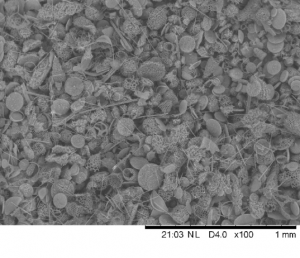
Big Fun with Tiny Plankton
(blog written by S. Moss)
With two weeks left of Expedition 385T, the JR Academy students are all scrambling to study the ocean through a variety of approaches. Several students are studying plankton on this trip. A plankter, an individual plankton, could be anything from algae to bacteria to crab larvae. “Planktos” means wandering, so it only makes sense that plankton includes all organisms that drift with the ocean. With such a wide range of organisms, plankton make up most of the Earth’s biomass and produce more oxygen than all other plants on Earth combined! There are hundreds of types of plankton that together create a critical source of protein for marine life.

To catch these plankton, we use what is called a plankton tow. The tows come in all sizes, from centimeters to several meters long (figure 1). Most tows used in the ocean are huge but with the supplies available we’re using freshwater nets loaned from Whatcom Community College. To use the tow, we drag it through the water and the thin mesh collects plankton, but lets water run through. After we use the nets we wash the plankton through sieves (basically a scientific sifter) and lay them out on slides. Once we collect our samples we head to the microscopes. Amanda Florea, a student at Whatcom Community College, is currently working on studying the plankton skeletons found in ocean sediment. The number of skeletons you can find is more than you might expect (figure 2)! She’s going to have a great eye for picking them out under a microscope after this experience.
I am studying the plankton found on the ocean’s surface, rather than the sediment. I hope to collect several samples and compare them to the skeletons found in the surface sediment collected on previous expeditions. I’m making a nice blend of field work and book work. At the end of the two weeks we will have two separate parts of a story that will come together smoothly to give us a more complete picture about plankton in this region.

During the next few weeks we’ll learn a lot about these tiny critters as we dive into their world and study them. Once we wrap up our research we will present them to the science staff on board to explain why this huge biomass of life is worth studying. To check out some other projects students are working on, click here.